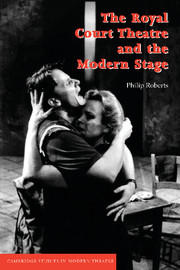Book contents
- Frontmatter
- Contents
- Foreword by Max Stafford-Clark
- Preface
- Acknowledgements
- List of abbreviations
- Biographical notes
- Introduction: abortive schemes, 1951–1954
- 1 Coincidences, 1954–1956
- 2 The struggle for control, 1956–1960
- 3 Conflict and competition, 1961–1965
- 4 A socialist theatre, 1965–1969
- 5 A humanist theatre, 1969–1975
- 6 Changing places, 1975–1979
- 7 Theatre in a cold climate, 1980–1986
- 8 Holding on, 1987–1993
- Afterword
- Notes
- Select bibliography
- Index
7 - Theatre in a cold climate, 1980–1986
Published online by Cambridge University Press: 22 September 2009
- Frontmatter
- Contents
- Foreword by Max Stafford-Clark
- Preface
- Acknowledgements
- List of abbreviations
- Biographical notes
- Introduction: abortive schemes, 1951–1954
- 1 Coincidences, 1954–1956
- 2 The struggle for control, 1956–1960
- 3 Conflict and competition, 1961–1965
- 4 A socialist theatre, 1965–1969
- 5 A humanist theatre, 1969–1975
- 6 Changing places, 1975–1979
- 7 Theatre in a cold climate, 1980–1986
- 8 Holding on, 1987–1993
- Afterword
- Notes
- Select bibliography
- Index
Summary
“I don't know if I want to be the director of a theatre, but if I do, it would be the Court”, he says. “Why?” “Because what else is there?”
(Victoria Radin, ‘Max at the Court’, Observer, 21 October 1979)On 1 January 1980, Stafford-Clark wrote in his Diary: ‘Lesson from Devine biography is one of continuity: how to develop the beliefs and roots we've started from. In my case, how to utilise the Traverse Workshop, Joint Stock and use that background for the Royal Court’. As Stafford-Clark tried to steer the Court through the eighties, he faced circumstances quite unlike his predecessors in their intensity and duration. This was not simply a matter of finance, critical though that was. It was also to do, in a less easily definable way, with the temper of the times. If the problems of the seventies were largely internal, the eighties saw a furious assault on most forms of art from external forces. Managing the well-being of a theatre like the Court over the decade involved strategic skills as well as aesthetic abilities. Stafford-Clark kept the Court together in a very difficult situation. In so doing, he attracted hostility as well as admiration, animosity as well as respect.
Unable to resist the obvious and neat, assorted critics reviewed the decade past. Nightingale loftily found that ‘Sometimes one felt benumbed with worthy boredom, notably at that social research unit which continues to call itself the Royal Court.’
- Type
- Chapter
- Information
- The Royal Court Theatre and the Modern Stage , pp. 170 - 194Publisher: Cambridge University PressPrint publication year: 1999



